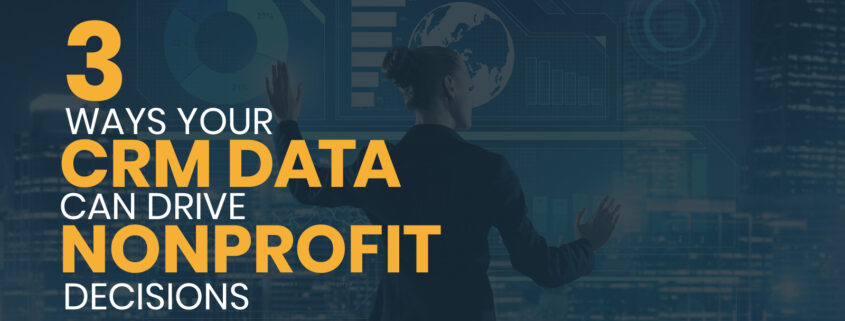3 Ways Your CRM Data Can Drive Nonprofit Decisions
For a nonprofit to truly impact the communities it serves, thoughtful decision-making must guide its fundraising efforts, programs, and other activities.
But to make these decisions, you must be equipped with more than just the authority of your leadership position.
A collection of data about your nonprofit’s work can give you the context you need to make crucial decisions, and your constituent relationship management (CRM) software is a treasure trove of this helpful information. Let’s take a closer look at three ways your CRM data can drive decision-making for your organization.
Encourage Further Involvement
Your nonprofit’s donors will make it to different points of the donor journey. The ones that stick around for the long haul are loyal supporters with whom you should develop strong relationships. Newly acquired or less involved donors simply have an ever-increasing potential to achieve a level of loyalty, and your CRM data can point both out.
Use your CRM data to understand donors’ giving frequencies and track important metrics, such as:
- Donor retention rate: What percentage of your supporters continue to give to your organization? Learning your donor retention rate can help you identify how many donors continue their involvement, which ones keep giving, and help you start thinking about how to increase that number. According to Double the Donation, you can also use the data from your CRM to develop a donor retention program that will help you encourage donors to continue giving in specific ways.
- Gift amount history: Is there a pattern or trend in giving? Can you see different data when you segment your audiences? If you discover that your fundraising trends increase seasonally, or with a certain demographic, you have insights on where to focus your efforts. When there’s a significant change from the historical data, you can address it—either by doubling down on what’s working or exploring what could be going wrong.
- Donor lifetime value: Donor lifetime value (LTV) is a critical metric for nonprofits. It not only shows you donor behavior in the past, but it can help you predict fundraising revenues in the future. LTV is also an important tool when your nonprofit is looking for major gift donors.
Equipped with this donor data, you’ll be able to better understand patterns of involvement. That way, your nonprofit can plan involvement opportunities that appeal to its supporters and encourage them to stay involved.
Communicate Based on Donor Segments
The data about your donors collected in your CRM can help you learn more about them and how to better communicate with them. Not only will you observe communication preferences, such as the channels your donors most actively engage with, but you’ll also learn what content appeals to them and how to craft your donation ask to most resonate with them.
Also, when your CRM manages donor communications for you, you can even more easily put this data to work. CharityEngine’s guide to nonprofit CRMs recommends searching for a CRM that streamlines donor communications through features such as:
- Email campaigns: The right CRM helps you create customized emails that represent your organization’s brand and populate supporters’ names in the salutation by using information from their donor profiles. For example, you can create a thank-you email using the donor’s name, email address, and information about the size of their gift and the program they supported.
- Direct mail marketing: Direct mail isn’t dead! Many nonprofits get most of their fundraising dollars from direct mail. When you have a CRM that offers all the tools fundraisers need, you can easily plug direct mail into a highly effective omnichannel campaign.
- Automated messages: Set up automated thank-yous to send recipients a quick confirmation immediately after a fundraiser. You might prepare different messages for each audience segment, such as a summary of the donation amount for donors and a recap of volunteer hours served for volunteers.
Be sure to keep additional communication data hygienic to avoid sending messages to the wrong contact information or targeting the wrong supporters. Conduct a data append to ensure all your information is correct, then maintain it by standardizing your data input processes and cleaning the database regularly.
Plan Future Fundraising Events
When you analyze your fundraising data, you’ll be able to better understand which efforts were successful, which ones weren’t, and how you can improve them to boost donations in the future. Track the following data through your CRM:
- Event attendance: This information can help you determine the most effective and appealing event types and activities to engage your supporters.
- Donor satisfaction: After your event, ask attendees what they thought. Was there an opportunity for them to engage, and at what rate did they engage? Figure out what worked so you can repeat it!
- Event revenue: It’s important to measure event revenue, but then dig deeper. What raised more money, the ticket sales or the auction? Drill down into where your nonprofit makes the most fundraising money.
Your data isn’t the only tool that will help you plan future fundraising events. The CRM itself can support your fundraising initiatives through features such as secure payment processing for nonprofits. After using data to plan your event, execute it well by leveraging your CRM’s other tools to make donating and getting involved easy for supporters.
Your nonprofit’s data is an important resource for decision-making. To add on to the data your CRM automatically collects, conduct your own research to learn even more about your donors and how you can improve your fundraising efforts. For example, you might send out a donor survey to ask for their opinions on a specific project and your approach to serving the community. The more data you have, the more accurate the conclusions you derive from it will be.



